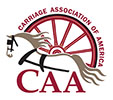Q. There seem to be different opinions about when russet harness is appropriate.
A. There was never any precise rule about this; it is really a matter of taste. In general it depends on the kind of carriage being used and whether it is intended to drive in the city or in the country. Russet harness was used in the country for informal occasions partly because it looked better in dusty conditions and was thought to be easier to clean.
Garland in “The Private Stable” advises buying black harness which is appropriate for all occasions, whereas russet has only a limited use. He lists the carriages to which russet harness might be used as including Runabouts; Lady’s Phaetons; Buckboards; Station Wagons; two-wheeled vehicles of a simple character. The latter would include Governess Carts, Road Carts (Meadowbrook, etc.); Village Carts, Tandem Carts of the ‘Going to Cover’ or Whitechapel sorts. A George IV Lady’s Phaeton with a groom in livery would not be an appropriate vehicle for russet harness.
The American Driving Society rules lay down that if black harness is used with a natural wood vehicle, then the leather trim on the shafts, etc. should also be of black leather. This is intended only as a guide for the show ring. [Please refer to the most current set of ADS rules.]
Russet harness of the best quality was higher priced than black, and this could still be the case, especially if pig-skin facings were wanted on winkers and saddles.
Originally printed in The Carriage Journal, Vol 18, No. 2.
